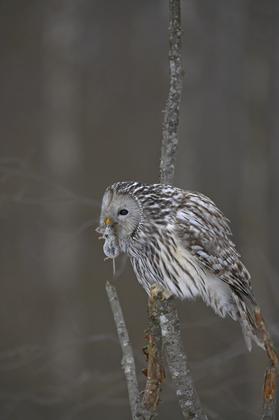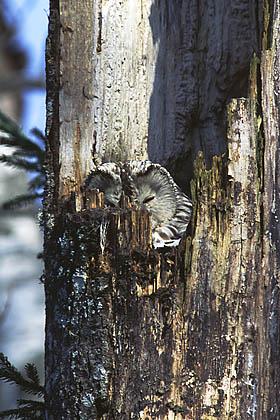Owl hooting time
Photos:Sven Zacek and Arne Ader
Nature sound: Veljo Runnel
Translation: Liis
Ural owl with mouse.
You are missing some Flash content that should appear here! Perhaps your browser cannot display it, or maybe it did not initialize correctly.
We can hear the calls of two Ural owls, a female and a male. The male bird's calls sound more clear, the female's somewhat hoarse.
| Ural owl | Händkakk |
The strong and sturdy Ural owl was earlier called "Ural owl“ in Estonian too; its present name, händkakk, means "tailed owl“. They used to populate coniferous forests, but by now have made themselves at home also in the western Estonian deciduous forests. On the islands they are only encountered as stray visitors. In addition to forests we meet the bird on the edge areas of bogs and marshes and hunting on felled areas and fields. The present „mouse year“ provides good conditions for nesting despite the hard winter. The Ural owl has a long body and tail, with a rather light-coloured plumage, pale grey rings round the eyes and dark eyes, the beak yellow, feet whitish, claws black; it blends nicely into the surrounding landscape.
At the coming of dusk the Ural owl picks a high vantage point to start its hunt as darkness falls ... All owls have wings with a large area and dense feathers that provide an advantage for gliding or flying nearly soundlessly. Orientation is by hearing: in front of the ears of owls are skin folds that concentrate sound waves.
Mating time is in winter-spring and the mating calls can be heard already in March. An owl forest is rich in sounds and as dusk falls somewhat scary sounds can be heard: whistling, groaning and hooting.
In the second half of April the clutch has been laid, and it is incubation time.
Ural owl at nest










